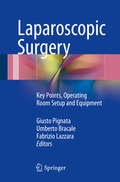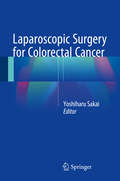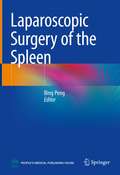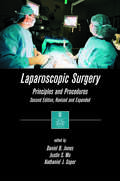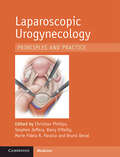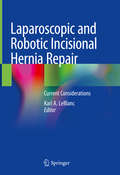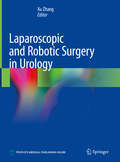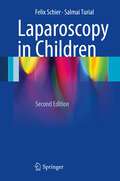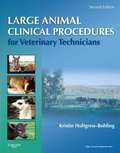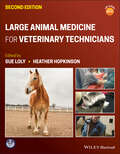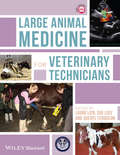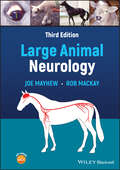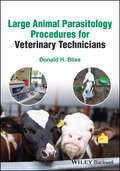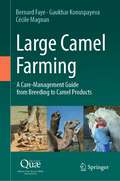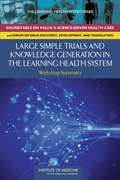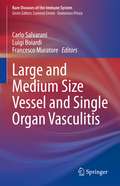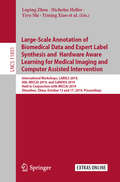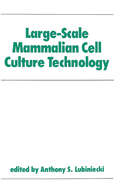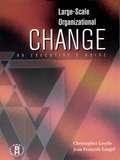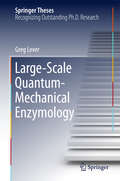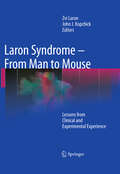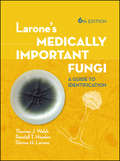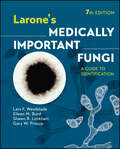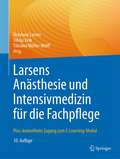- Table View
- List View
Laparoscopic Surgery
by Giusto Pignata Umberto Bracale Fabrizio LazzaraThis book is distinctive in that it is a truly practical guide to use of the laparoscopic approach for the treatment of many abdominal diseases. Rather than simply offering a general description of surgical laparoscopic techniques, it provides the knowledge required in order to introduce basic laparoscopic procedures into daily practice or to commence advanced laparoscopic surgery. For each surgical procedure, key points are highlighted, the necessary equipment is described, and the operating room setup essential to avoid errors or loss of time is explained. Many flow charts, tables, and figures are included to assist fast and intuitive comprehension. The book will be of interest to all of the "actors" in the operating room, including especially surgeons in training, established surgeons, nurses, and anesthetists.
Laparoscopic Surgery for Colorectal Cancer
by Yoshiharu SakaiThis book provides simplified principles of surgical anatomy for colorectal cancers with sophisticated drawings, standard laparoscopic procedures with striking photographs and illustrations, and advanced procedures such as lateral pelvic node dissection and "down to top" or "reverse" total mesorectal excision. Oncological safety as well as minimum invasiveness of laparoscopic surgery for colorectal cancer has been acknowledged worldwide, based on long-term outcomes of several randomized controlled trials comparing laparoscopic surgery and open surgery. Developments in optical devices have provided us with a magnified clear vision of fine anatomical structures, facilitating our understanding of surgical anatomy and surgical procedures have been refined and improved accordingly. All these topics are presented in this book--valuable for surgical residents and experts eager to learn more about laparoscopic colorectal surgery--and readers will be enlightened by a new paradigm for "lap-enhanced surgical anatomy". Therefore this volume will greatly benefit not only colorectal surgeons but also general surgeons as well as gastroenterologists and oncologists.
Laparoscopic Surgery of the Spleen
by Bing PengThis book presents the latest advances in laparoscopic spleen surgery. The first chapter reviews current status of laparoscopic spleen surgery, including indications, contraindications, and various types of surgical techniques. In the following three chapters, anatomy of spleen, pathology of spleen diseases, and perioperative management are described. After that, surgical techniques of laparoscopic splenectomy, single-incision laparoscopic splenectomy, hand-assisted laparoscopic splenectomy, and laparoscopic partial splenectomy are introduced with high-resolution illustrations combined with typical clinical cases. Focusing on minimally invasive surgery in spleen, this book will be a valuable reference for general surgeons, as well as practitioners in related disciplines.
Laparoscopic Surgery: Principles and Procedures, Second Edition, Revised and Expanded
by Daniel B. JonesExpanded by 30% to explore the latest surgical approaches, techniques, equipment, and perspectives, this Second Edition leads surgeons through new applications in minimally invasive surgery, gynecology, urology, endoscopically-assisted plastic surgery, pediatric surgery, and video-assisted thoracoscopic procedures.
Laparoscopic Urogynecology: Principles and Practice
by Christian Phillips Stephen Jeffery Barry O’Reilly Paraiso, Marie Fidela R. Bruno DevalLaparoscopic surgery for the treatment of disorders such as urinary incontinence and pelvic organ prolapse is evolving rapidly with few resources available for clinicians. This text will act as a gold standard reference in the field of laparoscopic urogynaecological surgery. The introductory section covers the basics of laparoscopy, including patient selection, surgical set up and the prevention and management of complications. Further sections focus on different “gold standard” techniques and the procedural steps needed to perform the surgery, including chapters on colposuspension, paravaginal repair, laparoscopic hysterectomy as well as apical suspensory surgery such as sacrocolpopexy and sacrohysteropexy. The final section includes debates and opinion pieces on newer techniques as well as discussion on the use of mesh in treating pelvic organ prolapse. There is also a section addressing the current rise in robotic surgery. The editors and contributors are all experts in the field, providing an authoritative and global view on techniques. Highly illustrated, with videos demonstrating the techniques, this is an eminently practical guide to the use of laparoscopy in urogynaecology.
Laparoscopic and Robotic Incisional Hernia Repair: Current Considerations
by Karl A. LeBlancThe field of hernia repair, in general, has evolved over the last 25 years. The changes that have followed the introduction of this technique have continued and have even increased in the last few years. There is a need to inform the practicing general surgeon about these advances. This text will seek to present the most up to date and important considerations to date. The book will open with a brief history and evolution of the technology surrounding the repair of incisional and ventral hernias laparoscopically and include the introduction of the robotic technology. Prosthetic biomaterials are an integral part of the successful repair of hernias and a comprehensive presentation of these products will be presented. Preoperative preparation of the patient has now been recognized as a method to improve outcomes in these patients and will be addressed.Technical aspects of the repair of these hernias will then follow in an orderly fashion to include the general considerations of the methodology. The “best practices” of these methods will be presented with appropriate figures and illustrations. The management of difficult situations as well as expected outcomes will be discussed. It is the intent of this text that any surgeon interested in the use of the minimally invasive techniques to repair the incisional and ventral hernias of the abdominal wall will have this resource presenting current opinions and methods. The “thought leaders” in these methods will be the authors of these chapters.This title differs from the Springer related title Novitsky, Hernia Surgery. The Novinsky is more comprehensive at 530 pages. It contains many more illustrations and video. The LeBlanc focuses on Laparoscopic and Robotic Hernia surgery with an estimated page count of 300-350. The LeBlanc presents current opinions of the thought leaders. Therefore, the subtitle: Current Considerations.
Laparoscopic and Robotic Surgery in Urology
by Xu ZhangThis book is a practical guide to the laparoscopic and robotic surgery technique in urology. It includes 34 chapters in three sections, which are adrenal gland, kidney and ureter surgery, bladder and prostate surgery and lympadenectomy. This book covers all parts of laparoscopic and robotic urological surgery, including methods in patient selection, peri-operative management, step-by-step descriptions of specific techniques and complication avoidance. It is accompanied with over 800 illustrations and real-time capture figures. It also includes over 40 surgery videos with online access. Through the combination of texts, pictures and videos, it presents the surgical designing, surgical procedures and surgical techniques in panorama. This book is a good reference book for urologists who interested in these techniques.
Laparoscopy in Children
by Salmai Turial Felix SchierWhen Laparoscopy in Children was first published in 2003, it quickly became popular with pediatric surgeons worldwide owing to its clear schematic drawings and concise text. This new edition has been revised and enlarged to cover the new procedures and other advances that have emerged in the intervening period, during which the number of operations has almost doubled. Now, the vast majority of indications for laparoscopy in children are presented and discussed. Each operation is systematically described and illustrated step by step, providing the reader with the technical guidelines required to perform laparoscopy safely even in small children. Laparoscopy in Children will be an invaluable guide for all surgeons who perform, or plan to perform, such operations.
Large Animal Clinical Procedures for Veterinary Technicians (2nd edition)
by Kristin J. Holtgrew-BohlingCovering the role of the veterinary technician in large-animal care, Large Animal Clinical Procedures for Veterinary Technicians, 2nd Edition provides a comprehensive guide to large-animal clinical diagnostic, medical, and surgical procedures. Not only does this book show why and how each procedure is performed, but it shows the vet tech's role in preparing for, assisting in, and following up on each one. Coverage of herd health care helps you understand the essentials of behavior and handling, safety, breeds, vaccination schedules, and common parasites. This edition adds case studies and clinical applications in each chapter, and a new section with an overview on livestock management. Written by educator and horse stable owner Kristin Holtgrew-Bohling, this book helps you pass your boards and gain certification, and can also be used as an on-the-job reference. A focus on the veterinary technician's role includes a description of each procedure in terms of the vet tech's responsibilities, explaining why and how the procedure is performed. Full-color photographs and line drawings show restraint, bandaging, physical examination techniques, and diagnostic procedures. A practical approach makes this text useful in classes and in clinical situations, so veterinary technicians, acting under instructions of veterinarians, can plan and follow through on procedures and treatment regimens for large animals. Proper medical terminology and common/layperson terminology are both used, helping you communicate effectively with clients and with other professionals. AVMA accreditation is promoted through coverage of the essential large animal-related tasks in the CVTEA Manual of Accreditation for Veterinary Technology Programs. New section on the livestock industry provides a wider background of herd health care so you can better understand the practices, procedures, and decisions of large animal veterinary medicine. New section on llamas and alpacas helps you understand the health and maintenance of these increasingly popular domestic animals -- in the U. S. , there are more than 12,000 alpaca herds and 25,000 llama owners. Emphasis on husbandry demonstrates how everyday housing and feeding affect care of common large animal diseases, including client education. Addition of case studies and clinical applications to each chapter helps you develop skills such as good history taking, decision making, and thinking on your feet. Coverage of herd health care includes behavior and handling, safety, breeds, vaccination schedules, and common parasites. Vet Tech Threads focus your learning with learning objectives, key terms, chapter outlines, and Technician Notes. Other added coverage includes photos of breeds and vaccination and parasite tables.
Large Animal Medicine for Veterinary Technicians
by Sue Loly Heather HopkinsonLarge Animal Medicine for Veterinary Technicians provides comprehensive guidance on caring for horses, cattle, camelids, small ruminants, pigs, and other farm animals. Reflecting the topics required by the American Veterinary Medical Association (AMVA), this practical resource covers hospital biosecurity, restraint, physical examinations, clinical and diagnostic procedures, reproduction, nutrition, disease, and more. Detailed chapters written by expert contributors contain numerous full-color images, clinical applications, self-review questions, and accurate, species-specific information. The second edition features revised and new content throughout, including brand-new chapters on common surgical procedures and general anesthesia, dentistry, and popular hobby farm animals such as fowl, poultry, and pet pigs. Updated and expanded sections on neonatology, diagnostics, and imaging are supported by a wealth of new images and examples. Covering the skills and knowledge necessary for success in both Veterinary Technician Specialty (VTS) programs and in clinical practice, this must-have guide: Offers new coverage of imaging and diagnostic technologies such as dynamic endoscoping and the use of treadmills Contains more than 500 high-quality color images, multiple-choice questions with answers, and a glossary of terms Features a range of pedagogical tools including learning objectives, clinical case problems, charts and diagrams, and “Technician Tip” boxes Includes a significantly expanded companion website with self-review questions, case studies, PowerPoint slides, and an image bank to aid in breed identification Authored and edited by experienced trainers and certified veterinary technicians, Large Animal Medicine for Veterinary Technicians, Second Edition an invaluable reference for all students, educators, and working professionals in the field.
Large Animal Medicine for Veterinary Technicians
by Sheryl Ferguson Laura Lien Sue LolyThis comprehensive guide to all aspects of caring for horses, cattle, camelids, small ruminants, and pigs helps veterinary technician students learn everything they need to know about large animal medicine. Presented in full-color, Large Animal Medicine for Veterinary Technicians provides species-specific coverage with a wealth of images, as well as clinical applications. Coverage includes AVMA-required topics such as hospital biosecurity, restraint, physical examinations, nutrition, clinical and diagnostic procedures, reproduction, neonatology, and disease. To reinforce the text, an accompanying website offers review questions and answers, case studies, and an image bank with additional photographs to aid in breed identification. Veterinary technician students, veterinary technician educators, and veterinary technicians in practice who wish to foster and expand their knowledge of large animal medicine will find Large Animal Medicine for Veterinary Technicians an invaluable resource.
Large Animal Neurology
by Joe Mayhew Rob MacKayA comprehensive and authoritative guide to neurologic disease in large domestic animals, world-wide. The newly revised Third Edition of Large Animal Neurology delivers a practical and complete reference for veterinarians, veterinary trainees and scientists dealing with large animal neurology. The book is vividly illustrated in full colour and contains many clinical photographs and detailed line drawings to highlight the concepts discussed within. Organised into three parts, Large Animal Neurology offers practitioners and students straightforward guides on how to perform neurologic examinations for domestic large animal species, including neonates. It also discusses the presenting clinical syndromes caused by common nervous system diseases, as well as giving details of the specific neurologic diseases of large domestic animals. The book includes: A thorough introduction to the evaluation of large animal neurologic patients, including discussions of neuroanatomy, neurologic evaluation, ancillary diagnostic aids, and the important pathologic responses of the nervous system Comprehensive exploration of 26 presenting clinical problems, including behaviour disorders, seizures, epilepsy, sleep disorders, blindness, strabismus, monoplegia, wobblers, tetraplegia, pruritus and cauda equina syndrome Detailed coverage of the specific diseases, including those of genetic, infectious, nutritional, toxic and metabolic cause, and the many diseases with multifactorial and with unknown cause Perfect for all equine and farm animal veterinarians, veterinary neurologists, as well as trainees in the field, Large Animal Neurology, Third Edition is also an ideal resource for undergraduate veterinary students, animal pathologists, and neuroscience researchers.
Large Animal Parasitology Procedures for Veterinary Technicians
by Donald H. BlissLarge Animal Parasitology Procedures for Veterinary Technicians Comprehensive illustrated reference on parasitic nematodes, cestodes, coccidian oocysts and trematode egg recoveries, identification, and enumeration with treatment strategies for five separate categories of animal patients Large Animal Parasitology Procedures for Veterinary Technicians illustrates, in detail, the most sensitive diagnostic procedure for internal parasites of domestic animals using the Modified Wisconsin Sugar Flotation Method. With step-by-step pictures and bullet-point instructions, this text discusses sample collection and storage techniques, as well as the strengths and weaknesses inherent to other commonly used tests. Potential sources for infection, the seasonality of the infection, possible environmental recontamination, and control strategies are all covered in detail, with suggestions to prevent reoccurrences. Parasites of the equine, large and small ruminants (including alpaca), swine, poultry and hoofed wildlife patients are included, with full color images for quick identification, an assessment of life cycle stage, and discussion of zoonotic potential. Each species section is heavily illustrated with comparative images to aid the technician in quickly identifying the parasite and life cycle stage. In Large Animal Parasitology Procedures for Veterinary Technicians, readers can find information on: The definition and economic importance of parasitisms, details on the epidemiology of parasitic enteritis, including basics of protozoology, helminthology, and overall applied veterinary parasitology Sample collection and shipment of specimens, including collection, storage, examinations, and interpretations Fecal examination using the Modified Wisconsin Sugar Flotation method, compared with gross examination, smear, sedimentation, and other flotation techniques, plus a fluke egg recovery technique and the Baermann technique for lungworm larvae recovery Internal parasite diagnosis and worm egg recoveries, descriptions and pictures of nematode parasite eggs (as well as coccidia oocysts), plus tapeworm eggs and fluke egg descriptions and photos for a variety of host animals Illustrating commonly used diagnostic tests in veterinary parasitology, with step-by-step instructions for accuracy, Large Animal Parasitology Procedures for Veterinary Technicians is an essential reference for veterinary technicians and veterinary technician students dealing with domestic animals, including horses, ruminants, swine, poultry, and hoofed wildlife.
Large Camel Farming: A Care-Management Guide from Breeding to Camel Products
by Bernard Faye Gaukhar Konuspayeva Cécile MagnanThis practical guide is intended for all actors in the sector who work with large camelids, whether in breeding, technical advice or veterinary care. It successively describes the general aspects of the species, the physiological bases of reproduction, lactation and feeding, the main production processes, and health and hygiene management in camel breeding. Chapters on slaughter, important camel products and their processing complete the volume.Large camels (camels and Bactrian camels) are domestic animals that are increasingly used in Western countries, as well as in Africa and Asia, for tourism, sport, and production of milk, meat, and wool. In addition, camel husbandry systems are changing, taking a greater share of sedentary systems, specializing in breeding, and intensifying production. At the same time, many veterinarians and breeders are not familiar with the animal, its needs, physiology, diseases, and management, which is often based on practices introduced for cattle and proving ineffective.This work is a practical aid for all interested readers who want to embark on the adventure of working with large camelids in a cultural context where they are not yet a dominant element of the agricultural landscape. The numerous photographs and drawings that support the text make it a unique and entertaining read.
Large Language Models (Methods in Molecular Biology #2941)
by Dukka B. KcThis book presents a comprehensive collection of methods, resources, and studies that use large language models (LLMs) in the field of protein bioinformatics. Reflecting the swift pace of LLM development today, the volume delves into numerous LLM-based tools to investigate proteins science, from protein language models to the prediction of protein-ligand binding sites. Written for the highly successful Methods in Molecular Biology series, chapters include the kind of detailed implementation advice to ensure success in future research. Authoritative and practical, Large Language Models (LLMs) in Protein Bioinformatics serves as an ideal guide for scientists seeking to tap into the potential of artificial intelligence in this vital area of biological study.
Large Simple Trials and Knowledge Generation in a Learning Health System
by Institute of Medicine Forum on Drug Discovery, Development, and Translation Board on Health Sciences Policy Rebecca A. English Julia Sanders Roundtable on Value and Science-Driven Health Care Claudia GrossmannRandomized clinical trials (RCTs) are often referred to as the "gold standard" of clinical research. However, in its current state, the U.S. clinical trials enterprise faces substantial challenges to the efficient and effective conduct of research. Streamlined approaches to RCTs, such as large simple trials (LSTs), may provide opportunities for progress on these challenges. Clinical trials support the development of new medical products and the evaluation of existing products by generating knowledge about safety and efficacy in pre- and post-marketing settings and serve to inform medical decision making and medical product development. Although well-designed and -implemented clinical trials can provide robust evidence, a gap exists between the evidence needs of a continuously learning health system, in which all medical decisions are based on the best available evidence, and the reality, in which the generation of timely and practical evidence faces significant barriers. Large Simple Trials and Knowledge Generation in a Learning Health System is the summary of a workshop convened by the Institute of Medicine's Roundtable on Value & Science-Driven Health Care and the Forum on Drug Discovery, Development, and Translation. Experts from a wide range of disciplines--including health information technology, research funding, clinical research methods, statistics, patients, product development, medical product regulation, and clinical outcomes research--met to marshal a better understanding of the issues, options, and approaches to accelerating the use of LSTs. This publication summarizes discussions on the potential of LSTs to improve the speed and practicality of knowledge generation for medical decision making and medical product development, including efficacy and effectiveness assessments, in a continuously learning health system. Large Simple Trials and Knowledge Generation in a Learning Health System explores acceleration of the use of LSTs to improve the speed and practicality of knowledge generation for medical decision making and medical product development; considers the concepts of LST design, examples of successful LSTs, the relative advantages of LSTs, and the infrastructure needed to build LST capacity as a routine function of care; identifies structural, cultural, and regulatory barriers hindering the development of an enhanced LST capacity; discusses needs and strategies in building public demand for and participation in LSTs; and considers near-term strategies for accelerating progress in the uptake of LSTs in the United States.
Large and Medium Size Vessel and Single Organ Vasculitis (Rare Diseases of the Immune System)
by Carlo Salvarani Luigi Boiardi Francesco MuratoreIn this book, detailed information on the nosology, pathology, pathogenesis, clinical presentation, diagnosis and treatment of large- and medium-sized vessel and single-organ vasculitis is provided and critically discussed by the most expert physicians and researchers in the field. Among the conditions considered are giant cell arteritis, Takayasu arteritis, polyarteritis nodosa, primary central nervous system vasculitis, isolated aortitis, isolated gastrointestinal vasculitis, cutaneous vasculitis and isolated genitourinary vasculitis. The role of histopathology in the diagnosis and prognosis of these vasculitis is evaluated, along with the part played by imaging studies in diagnosing and monitoring these diseases, while indications and limitations of the available imaging modalities are discussed as well. The expanding role of biological agents for the treatment of the large vessel vasculitis is addressed, as well as the current approaches to these diseases. This book will be a valuable companion in decision-making for medical practitioners, internists, specialists, researchers and postgraduate students interested in the intriguing fields of vasculitis and rare diseases.
Large-Scale Annotation of Biomedical Data and Expert Label Synthesis and Hardware Aware Learning for Medical Imaging and Computer Assisted Intervention: International Workshops, LABELS 2019, HAL-MICCAI 2019, and CuRIOUS 2019, Held in Conjunction with MICCAI 2019, Shenzhen, China, October 13 and 17, 2019, Proceedings (Lecture Notes in Computer Science #11851)
by Emanuele Trucco Diana Mateus Veronika Cheplygina Yiming Xiao Hassan Rivaz Ingerid Reinertsen Matthieu Chabanas Raphael Sznitman Luping Zhou Yiyu Shi Nicholas Heller X. Sharon Hu Danny ChenThis book constitutes the refereed joint proceedings of the 4th International Workshop on Large-Scale Annotation of Biomedical Data and Expert Label Synthesis, LABELS 2019, the First International Workshop on Hardware Aware Learning for Medical Imaging and Computer Assisted Intervention, HAL-MICCAI 2019, and the Second International Workshop on Correction of Brainshift with Intra-Operative Ultrasound, CuRIOUS 2019, held in conjunction with the 22nd International Conference on Medical Imaging and Computer-Assisted Intervention, MICCAI 2019, in Shenzhen, China, in October 2019. The 8 papers presented at LABELS 2019, the 5 papers presented at HAL-MICCAI 2019, and the 3 papers presented at CuRIOUS 2019 were carefully reviewed and selected from numerous submissions. The LABELS papers present a variety of approaches for dealing with a limited number of labels, from semi-supervised learning to crowdsourcing. The HAL-MICCAI papers cover a wide set of hardware applications in medical problems, including medical image segmentation, electron tomography, pneumonia detection, etc. The CuRIOUS papers provide a snapshot of the current progress in the field through extended discussions and provide researchers an opportunity to characterize their image registration methods on newly released standardized datasets of iUS-guided brain tumor resection.
Large-Scale Mammalian Cell Culture Technology (Biotechnology And Bioprocessing Ser. #10)
by LubinieckiAn interdisciplinary approach, integrating biochemistry, biology, genetics, and engineering for the effective production of protein pharmaceuticals. The volume offers a biological perspective of large-scale animal cell culture and examines diverse processing strategies, process management, regulator
Large-Scale Organizational Change: An Executive's Guide
by Christopher Laszlo Jean Francois LaugelLarge Scale Organizational Change provides the principles by which large scale organizations reinvent themselves not once, but on an ongoing basis. Continual reinvention allows leading companies to learn, adapt, and innovate faster than competitors in complex and fast changing environments. These action principles are based on first-hand experience at the world's leading Fortune 500 companies using emergent models of living systems.The context for large scale organizations is one of information overload, complexity and constant change. This book reduces the sense of vulnerability felt by managers. It provides a guide to piloting change in ways that lead to constant renewal and a capacity to survive frequent and often brutal changes in the operating environment. It describes a leadership concerned with the capacity to learn, inflection points, emergent strategies, knowledge management, the ability to anticipate, and tapping into the distributed intelligence resident in the organization. Large Scale Organizational Change provides managers with a framework for making their organizations highly adaptive in the complex market systems in which they operate, thereby reducing or eliminating the need for periodic episodes of traumatic restructuring and sometimes fatal reengineering processes.
Large-Scale Quantum-Mechanical Enzymology
by Greg LeverThis work establishes linear-scaling density-functional theory (DFT) as a powerful tool for understanding enzyme catalysis, one that can complement quantum mechanics/molecular mechanics (QM/MM) and molecular dynamics simulations. The thesis reviews benchmark studies demonstrating techniques capable of simulating entire enzymes at the ab initio quantum-mechanical level of accuracy. DFT has transformed the physical sciences by allowing researchers to perform parameter-free quantum-mechanical calculations to predict a broad range of physical and chemical properties of materials. In principle, similar methods could be applied to biological problems. However, even the simplest biological systems contain many thousands of atoms and are characterized by extremely complex configuration spaces associated with a vast number of degrees of freedom. The development of linear-scaling density-functional codes makes biological molecules accessible to quantum-mechanical calculation, but has yet to resolve the complexity of the phase space. Furthermore, these calculations on systems containing up to 2,000 atoms can capture contributions to the energy that are not accounted for in QM/MM methods (for which the Nobel prize in Chemistry was awarded in 2013) and the results presented here reveal profound shortcomings in said methods.
Laron Syndrome - From Man to Mouse
by Zvi Laron J. KopchickLaron syndrome (LS), or primary growth hormone (GH) insensitivity, was first described in 1966. Since then, many patients worldwide have been diagnosed with LS, which involves defects in the GH receptor that cause combined congenital deficiency of GH and IGF-I activities. In this comprehensive book the authors draw upon 50 years of multidisciplinary clinical and investigative follow-up of the large Israeli cohort of LS patients. The genetic basis of the syndrome is fully considered, and all aspects of the pathophysiology of IGF-I deficiency are described. Data derived from the recently generated mouse model of LS are reviewed and compared with the human LS experience. Valuable advice is provided on treatment, and treatment effects, such as metabolic effects, adipose tissue alterations, and impact on aging, are fully explored. Together, this book condenses, consolidates, compares, and contrasts data derived from the human and mouse LS experiences and provides a unique resource for clinical and basic scientists to evaluate and compare IGF-I and GH actions.
Larone's Medically Important Fungi: A Guide to Identification (ASM Books)
by Randall T. Hayden Thomas J. Walsh Davise H. LaroneThe definitive guide for identifying fungi from clinical specimens Medically Important Fungi will expand your knowledge and support your work by: Providing detailed descriptions of the major mycoses as viewed in patients' specimens by direct microscopic examination of stained slides Offering a logical step-by-step process for identification of cultured organisms, utilizing detailed descriptions, images, pointers on organisms' similarities and distinctions, and selected references for further information Covering nearly 150 of the fungi most commonly encountered in the clinical mycology laboratory Presenting details on each organism's pathogenicity, growth characteristics, relevant biochemical reactions, and microscopic morphology, illustrated with photomicrographs, Dr. Larone's unique and elegant drawings, and color photos of colony morphology and various test results Explaining the current changes in fungal taxonomy and nomenclature that are due to information acquired through molecular taxonomic studies of evolutionary fungal relationships Providing basic information on molecular diagnostic methods, e.g., PCR amplification, nucleic acid sequencing, MALDI-TOF mass spectrometry, and other commercial platforms Including an extensive section of easy-to-follow lab protocols, a comprehensive list of media and stain procedures, guidance on collection and preparation of patient specimens, and an illustrated glossary With Larone's Medically Important Fungi: A Guide to Identification, both novices and experienced professionals in clinical microbiology laboratories can continue to confidently identify commonly encountered fungi.
Larone's Medically Important Fungi: A Guide to Identification (Asm Bks.)
by Gary W. Procop Lars F. Westblade Eileen M. Burd Shawn R. LockhartLarone’s MEDICALLY IMPORTANT FUNGI The definitive guide for identifying fungi from clinical specimens With a new team of authors, Larone’s Medically Important Fungi, Seventh Edition, continues the longstanding tradition of high-quality content to expand your knowledge and support your work in clinical mycology by: Providing detailed descriptions of the major mycoses as viewed in patients’ specimens by direct microscopic examination of stained slidesOffering a logical step-by-step process for identification of cultured organisms, utilizing detailed descriptions, images, pointers on organisms’ similarities and distinctions, and selected references for further informationCovering more than 150 of the fungi most commonly encountered in the clinical mycology laboratory, including new entries for Emergomyces, Metarhizium anisopliae, Rasamsonia argillacea, Rhinocladiella mackenziei, Schizophyllum commune, and Thermothelomyces thermophilusPresenting details on each organism’s pathogenicity, growth characteristics, relevant biochemical reactions, and microscopic morphology, illustrated with photomicrographs, unique and elegant drawings, and color photos of colony morphology and various test resultsExplaining changes in fungal taxonomy and nomenclature that are due to information acquired through molecular taxonomic studies of evolutionary fungal relationshipsProviding basic information on molecular diagnostic methods, e.g., nucleic acid amplification and sequencing, MALDI-TOF mass spectrometry, and other commercial platformsIncluding an extensive section of easy-to-follow lab protocols, a comprehensive list of media and stain procedures, guidance on collection and preparation of patient specimens, and an illustrated glossary With Larone’s Medically Important Fungi: A Guide to Identification, both novices and experienced professionals in clinical microbiology laboratories can confidently identify commonly encountered fungi.
Larsens Anästhesie und Intensivmedizin für die Fachpflege: Plus: kostenfreier Zugang zum E-Learning-Modul
by Reinhard Larsen Tobias Fink Tilmann Müller-WolffMit dem „Larsen“ haben Sie das Standard-Lehrbuch in der Hand, das Sie durch die Fachweiterbildung und in der Praxis begleitet! Alle Inhalte systematisch aufbereitet, verständlich und nachvollziehbar erklärt, mit zahlreichen Abbildungen und Tabellen ergänzt. Praxisnahe Tipps für den Umgang mit dem Patienten, aktuelle Literatur für Wissbegierige und ein übersichtliches Glossar machen das Werk besonders praxistauglich.Aus dem InhaltGrundlagen und Verfahren in der Anästhesie und Anästhesiepflege Postoperative VersorgungGrundlagen der Intensivmedizin und IntensivpflegeLunge, Atmung, Beatmung, WeaningHerz-Kreislauf-Funktion und ihre StörungenNiere, Wasser-Elektrolyt- und Säure-Basen-HaushaltSpezielle Intensivmedizin in den verschiedenen FachgebietenDie 10. Auflage, nun unter interprofessioneller Herausgeberschaft. Komplett aktualisiert und um folgende Themen erweitert: Anästhesie in der Gynäkologie und bei geriatrischen Patienten, innerklinische Reanimation, spezielle Intensivpflege, Intensivbehandlung der Covid-19-Krankheit. Ein Muss für alle Pflegekräfte auf Intensivstation oder in der Anästhesie, Fachweiterbildungsteilnehmer und Lehrkräfte. Auch für Ärzte zum Lernen und Lehren ein bewährtes Nachschlagewerk! Plus: kostenfreier Zugang zum E-Learning-Modul mit Fragen und Antworten!
